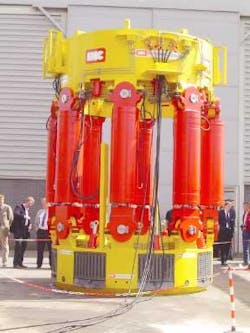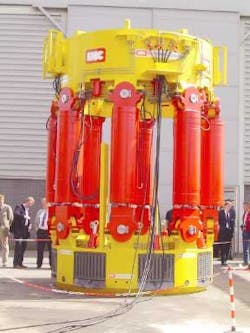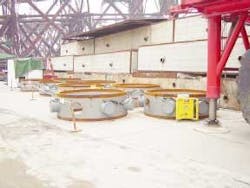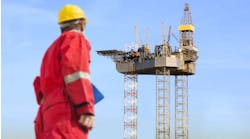Trials of the world's most powerful subsea jacket leveling tool are progressing according to plan. Developer IHC Handling Systems recently undertook functional and pressure tests at its headquarters in Delfgauw, The Netherlands, witnessed by an audience of oil industry clients. The new system provides a pulling capacity of up to 3,000 tonnes – a quantum leap for IHC, as its previous pull maximum for a single leveling tool was 400 tonnes.
Impetus for the new development came from Saipem, which was seeking a 3,000-tone-capacity tool for its installation in September of the Sabratha platform jacket offshore Libya. This 202-m, 22,000-tonne eight-legged steel structure, built by Intermare Sarda in Sardinia, will be installed by the crane barge S7000 in 190 m of water. Sixteen 147-m, 96-in.-diameter piles, manufactured by Rossetti Marino in La Spezia, will be grouped into clusters of four sleeves, one at each corner of the jacket base.
IHC's solution comprises two clamps with eight cylinders in between. Both clamps have a working load limit (WLL) of 3,000 tonnes, and a similar total pull capacity. The company's existing tools each feature only one leveling cylinder, with a gripper head at the end that makes a connection onto the catcher plate on top of the skirt sleeve.
null
The lower clamp of the new leveling system features a thick, mach-ined ring, with eight wedges spaced equally around its circumference on the outside.
Hardened alloy steel gripping elements (buttons) embedded in the wedges grip themselves into a vertical steel ring, which is part of the stepped guide cone welded on top of the skirt pile gripper. Clamping and releasing is effected via the cylinders (one on each of the wedges). To prevent one or more cylinders reaching end of stroke, the ring is centralized prior to gripping by means of centralizing cylinders.
A similar configuration applies to the upper clamp, except that here the wedges are spaced equally around the circumference on the inside of the ring. The upper clamp can be equipped with spacers for 84-in, 96-in., and 102-in. piles.
According to sales manager Marc Doorduin, for Sabratha (and probably also for subsequent jobs), the tool will be brought down attached to a follower. After the latter has been stabbed into the foundation pile, the leveling cylinders are activated: the bottom ring is then lowered into the skirt sleeve's stepped guide cone. On arrival at the base of this cone, the centralized cylinders are operated to ensure that the lower clamp is positioned with equal spacing at all sides. The next step is for the bottom ring's clamp cylinders also to be activated.
Once this procedure is in place, a temporary connection will have been effected between the foundation pile and skirt sleeve. The eight leveling cylinders can now be retracted, and as a result this complete corner of the jacket will be lifted against the pile. On reaching the required height, the jacket pile gripper system is activated to maintain the newly elevated position. The bottom ring's clamp cylinders can then also be retracted, with the leveling tool free to return to the surface.
"Bringing the tool down in combination with a follower makes handling subsea easier," Doorduin says. "The top clamping cylinders can be activated at the surface, which saves valuable time."
null
The system's required load test was due to be staged last month in Delfgauw and witnessed by Lloyds Register and representatives of Saipem.
The new leveling tool may also be deployed by the S7000 for leveling one of the Buzzard field jackets in the UK central North Sea, in combination with four 3,000-tonne pile grippers. These were due to be delivered by IHC to the Aker Verdal yard in Norway during July. Originally, IHC had been contracted to supply 12 pile grippers for all three Buzzard jackets, but this was later scaled back by operator EnCana to four grippers for one jacket.
According to Doorduin, "Normally, a pile gripper is built up from a number of hydraulic gripper cylinders which are all connected together to a mutual supply and return line. Should a malfunction occur in either the supply or return line or in any of the cylinders – i.e. a leakage seal – all pressure will be lost, likewise the load-holding force. By dividing the total number of cylinders into groups, the risk is spread. In Buzzard's case, 12 cylinders were divided into four groups of three. Operating this subsea entails a large ROV panel crammed with valves and pressure gauges.
"We supplied Verdal with four pc 3,000-tonne pile gripper systems complete with stepped guide cone to accommodate our 3,000-tonne leveling tool, with a catcher on top of the cone. The ROV panel is mounted to the lower part of the stepped guide cone. Normally, we would attach this to the gripper ring."
IHC will also set a record on ChevronTexaco's Benguela/Belize development offshore Angola. Here it is supplying what is claimed to be the world's biggest external lifting tool (ELT) to Heerema for installation of the field's compliant tower. This tool, measuring 2.17 m high and 5.13 m in diameter, will be able to lift piles in a diameter range of 84 to 108-in. For 84-in. piles, the tool weight is actually heavier (73 tonnes) than for larger diameter piles (60 tonnes). "In 84-in. mode," Doorduin explains, "you need to add spacers, which in turn increase the weight." The ELT's vertical safe working load (SWL) is 1,200 tonnes for upending applications, with a horizontal SWL of 800 tonnes.
In the run-up to delivery this October, the tool will undergo the following test procedures:
Pressure test Functional test without pile
- First, load test horizontal at 1.5 times 800 tonnes (1,200 tonnes)
- Second, load test horizontal at 800 tonnes, with an unequal load distribution on the pad eyes
- Third, load test vertical at 1.5 times 1,200 tonnes (1,800 tonnes).
"Due to the complexity of this tool and the importance of the project, a team involving the customer and IHC personnel is meeting twice-weekly to review continuation of the design, engineering and production," says Doorduin.





